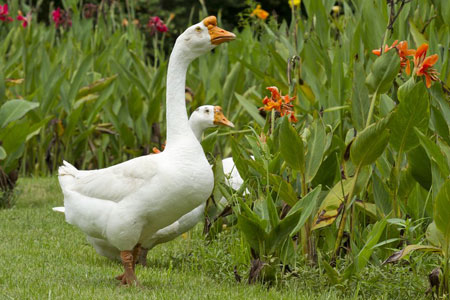
For some types of poultry, determining a bird’s gender is easy. Other times not so. Here’s a quick rundown on how to sex poultry, including chickens, turkeys, guinea fowl, ducks, and geese.
Chickens
Some baby chicks may be sexed at the time of hatch by differences in down color. Otherwise, the easiest way to sex a chicken is to watch for greater development of the roosters’ combs and wattles.
Maturing roosters of most breeds also develop pointy neck and saddle features, while the hens’ feathers are rounded at the ends. Roosters typically develop longer spurs, too, although in some breeds hens also grow spurs.
And, of course, roosters crow. Well, most of the time roosters do the crowing. Once in awhile a hen will take on the job. A hen has the same acoustical equipment as the male and therefore has the ability to crow, but few hens do.
Turkeys
Practically from the day of hatch the little male turkeys fan their tails and strut. When they reach about 10 weeks of age, they start to develop pale fleshy wart-like head bumps, or caruncles.
Male turkeys also develop a loose growth called a snood hanging from the top of the beak. When a tom gets excited his snood gets long and floppy and his caruncles turn a brilliant red.
Mature males also grow a beard from the chest. But a hen, too, may grow a beard.
A turkey hen is somewhat smaller and less colorful than the male. She generally has more head feathering. And she has smaller feet and thinner shanks. A hen may occasionally strut like a tom, much more briefly and usually only after she is fully mature. But her tiny snood won’t grow long and floppy and her face won’t glow like the tom’s.
Guinea Fowl
Many people have trouble sexing guineas, even when the birds are fully mature. The clues in size, behavior, posture, and headgear can be quite subtle.
Male guineas are a tad bigger than females. And they tend to be more aggressive. While foraging, the males are generally alert, while the females seem intent on finding tidbits on the ground.
A male guinea generally has a larger, more upright knob on top of his head. And his wattles are slightly larger, thicker, and more deeply cupped.
Males and females both make a raucous chattering sound, especially when alarmed. But only the females make a two-syllable call. It sounds like “good luck” or “come back,” with emphasis on the second part. The hens start calling at about six weeks of age, well before any other distinguishing features become apparent. But good luck trying to figure out which ones are saying “good luck.”
Ducks
Ducks, too, may be sexed by the sounds they make. Females of most breeds quack loudly. Males do not quack. Mature male ducks, or drakes, have curly tail feathers, but not all year long. And occasionally a female has a curly tail.
In some breeds the males and females differ in plumage color as they mature. During part of the year, though, males of these breeds molt and take on the same plumage color as the females.
However, drakes are generally larger and heavier than the hens. And they have thicker, more wide-set legs and larger feet. So those features, and loud quacking, are the clues to look for at times of year when both genders wear the same color plumage.
Geese
For most people, geese are more difficult to sex than any other poultry. Male geese, or ganders, tend to be slightly larger and more masculine in appearance than the hens. Mature females tend to be baggier and lower slung between the legs. You can see these differences in the above photo.
But these differences are sometimes subtle, so a typical way to verify gender, even of mature geese, is through vent sexing. On the other hand, sometimes a gander has such a tiny penis that vent sexing may not be reliable.
When learning to sex poultry of all species, in time you will begin to recognize even the minor differences in the way males and females appear, move, and act. One day you will suddenly realize you have become proficient in distinguishing gender at a glance.
And that’s today’s news from the Cackle Coop.
Gail Damerow has written numerous books about poultry, including The Backyard Homestead Guide to Raising Farm Animals, which includes chapters on chickens, turkeys, and waterfowl as well as a variety of four-legged livestock.

